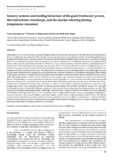Sensory systems and feeding behaviour of the giant freshwater prawn, Macrobrachium rosenbergii, and the marine whiteleg shrimp, Litopenaeus vannamei
- Global styles
- MLA
- Vancouver
- Elsevier - Harvard
- APA
- Help

Download URL
jurcon.ums.edu.myDate
2017Page views
1,713AGROVOC keyword
Taxonomic term
Metadata
Show full item record
Share
Abstract
Information on the sensory basis of shrimp feeding provides the means for assessment of the effectiveness of food items in terms of smell, taste, size, and colour. This chapter summarizes information about the sensory basis of the feeding behaviour of the giant freshwater prawn (Macrobrachium rosenbergii) and the marine whiteleg shrimp (Litopenaeus vannamei). Existing literature on these shrimp species and other decapod crustaceans is reviewed, and unpublished experiments using the selective sensory ablation technique to determine the involvement of vision, chemoreception, and touch sense in the feeding behavior of the juveniles of M. rosenbergii and L. vannamei are also described. To determine the role of vision in feeding, the eyes of the juveniles were painted over (deprived of vision) with white manicure and their feeding response to commercial pellets was compared with those with untreated eyes. The untreated eyed juveniles detected and approached a feed pellet right away, but the specimens blinded by the coating detected a pellet only after random accidental touch with the walking legs while roaming on the aquarium bottom. Juveniles that had learned to feed on pellets showed food search and manipulation responses to a pellet-like pebble without smell and taste. The early larvae (zoeae) of M. rosenbergii already have colour vision (that likely persists through life) and colour preference for blue and white. The adults of L. vannamei discriminated a blue-colored well among seven grey wells in a palette, also showing colour vision in this shrimp. A behavioural experiment with dyed prawn flesh showed that L. vannamei has innate color preference for yellow food over black, red, green, and blue food regardless of the background colours of the aquarium bottom. To disrupt chemoreception, the juveniles of both the species were abruptly transferred to water of drastically different salinity and the osmotic ablation destroyed the chemosensitive sensilla. The osmotically ablated juveniles approached a pellet right away but failed to ingest it; they had learned the visual cue and texture of the pellets and recognized them by vision and tactile sense. To determine the role of sensory appendages in feeding of L. vannamei juveniles, the antennal flagella, antennular flagella, and the pincers of the pereiopods were ablated. The ablated juveniles roamed the bottom, touched a pellet at random, grabbed it with the maxillipeds, and ingested it. Subsequently they learned to lower the head, actively swim forward, sweep the bottom with the maxillipeds, detect a pellet, and ingest it—thus indicating a plasticity in feeding behaviour in L. vannamei.
Suggested Citation
Kawamura, G., Bagarinao, T., & Yong, A. S. K. (2017). Sensory systems and feeding behaviour of the giant freshwater prawn, Macrobrachium rosenbergii, and the marine whiteleg shrimp, Litopenaeus vannamei. Borneo Journal of Marine Science and Aquaculture , 1, 80-91. http://hdl.handle.net/10862/3233
Type
ArticleCollections
- Journal Articles [1258]



